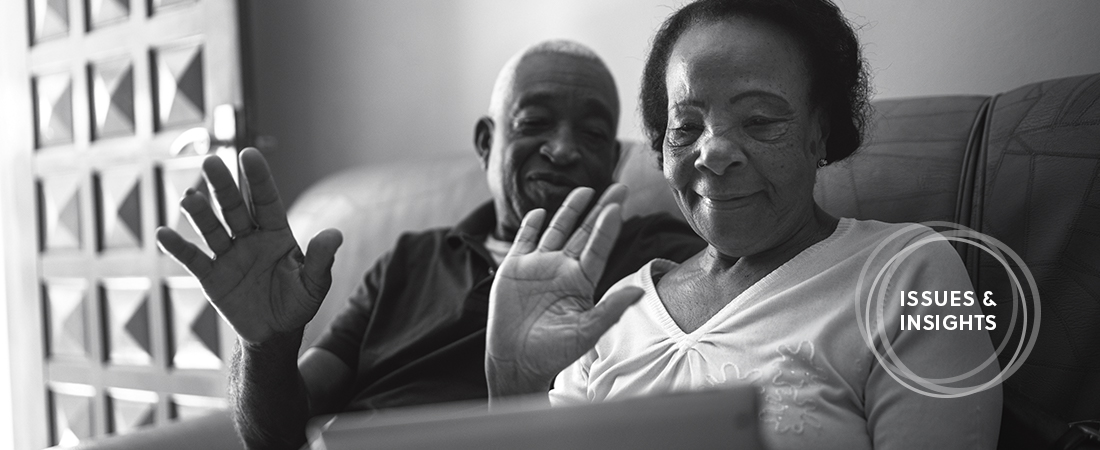Why COVID-19 May Increase Elder Abuse—And How We Can Prevent It

Approximately 1 in 10 Americans aged 60 years and older have experienced some form of elder abuse, with as many as 5 million older adults abused each year. A national study suggests only 1 in 14 cases are reported to authorities.
—National Council on Aging, “Elder Abuse Facts: What Is Elder Abuse?”
Research suggests the confinement, isolation, and stress brought on by the coronavirus pandemic is linked to a worldwide increase in domestic violence and child abuse. Though less well-publicized, the COVID-19 crisis may also increase risks for older adults, including physical, sexual, or psychological abuse, as well as financial exploitation or neglect by caregivers.
“Elder mistreatment is a prevalent issue, and it’s been a problem for a long time,” says EDC public health researcher Kristin Lees-Haggerty. “COVID-19 is exacerbating the issue in many ways.”
Lees-Haggerty directs the National Collaboratory to Address Elder Mistreatment, a team of experts and clinicians who are designing and testing a care model to identify and respond to elder mistreatment in emergency departments (EDs). She discusses how this pilot program, administered by EDC with funding from The John A. Hartford Foundation, the Gordon and Betty Moore Foundation, and the Health Foundation for Western and Central New York, is working amid the pandemic and what we all can do to support older adults in our communities.
Q: Why has the COVID-19 crisis increased the risk for elder mistreatment?
Lees-Haggerty: When the pandemic hit in March, we quickly realized that this could really increase the risk for elder mistreatment, because now older adults are even further isolated, with reduced access to health care and other services. The pandemic is also reducing access to respite services for caregivers and increasing existing stressors that might make it more likely for a person to be abusive. These include unemployment, food insecurities, and lack of access to mental health and substance use services.
Q: How has the pandemic affected emergency departments?
Lees-Haggerty: It has posed a lot of challenges for ED staff. Staff are often concerned about their own health and safety, especially given the uncertainty around whether PPE [personal protective equipment] will be available. They are dealing with staff shortages, too. However, ED staff have continued to screen for elder mistreatment. They recognize the importance of screening, especially during the pandemic, and are making sure that it happens—even as they are adjusting to the many changes brought on by COVID-19.
We launched our pilot program in five EDs in January and February, and provided them with tools to ask key questions of each older patient and to make observations that might indicate signs of physical or emotional abuse and caregiver neglect. We were really pleased they’ve carried on this work despite the challenges.
Q: What can health care providers in EDs do if they suspect elder abuse?
Lees-Haggerty: Health care providers should report suspected elder mistreatment in line with the mandates in their state. Usually, reports should go to their local Adult Protective Services agency. Because reporting requirements vary by state, health care professionals really need to be aware of the mandates in their state.
The Emergency Department Elder Mistreatment Toolkit that we are piloting includes tools to guide clinicians through an elder abuse screening and, as appropriate, a response process. It also has a road map for connecting with community resources that can provide more follow-up and support once the older adult leaves the relative safety of the hospital. When patients screen positive for suspected mistreatment, the response protocol includes documenting and reporting concerns, determining whether there is a safe place to discharge the older adult to, and working with the older adult to develop a safety plan and to connect them with additional community resources.
Our goal is to prepare ED staff with streamlined training and tools. We want them to efficiently identify and respond to elder mistreatment and provide a patient-directed approach to discharge and follow-up.
Q: What can the average person do to prevent elder mistreatment?
Lees-Haggerty: One of the most important ways that we can prevent elder mistreatment is to increase social connectedness with older adults and their caregivers. Right now, it’s more difficult, sometimes impossible, to be physically close to the older adult friends, family members, and neighbors in our communities. But there are other ways that we can connect.
I would encourage all of us to pick up the phone to call or FaceTime, send photos over email, meet people outside from a safe distance, and connect with older adults. The same thing goes for caregivers. Call your friend who lives with a mom who has dementia and give them a chance to talk about it. Ask how you can help. “Can I drop off dinner for you this week?” “Is it safe for me to come help you so you can have an hour to yourself?” Those sorts of things can go a long way.
